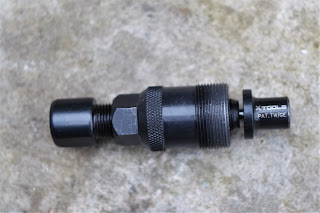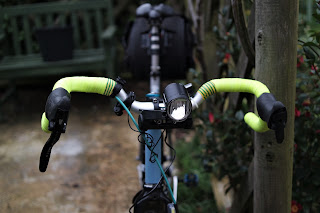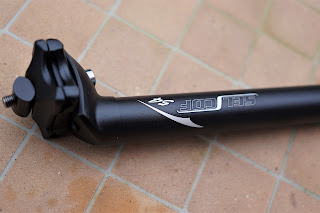My Univega’s gearing has
always been something of a compromise, since 2017’s new paint and 1X9 makeover.
A 34-tooth ring and 11-30 cassette would’ve been too low.
The 44x11-28 gives a range
between 103 and 40.5 inches, which is generally practical for road duties,
although, I’ve missed the additional torque offered by the 30- tooth sprocket. Especially
when climbing a 1 in 7 and battling a headwind. Plenty of the latter, this past
fortnight, or so.
Having just replaced the chain
and cassette, buying another would’ve been silly, so I turned my attention to
the front ring. 94 BCD…Nothing suitable “in stock” but a witching hour wander
round the web, unearthed a black 42 tooth Talon for £9.99. Apparently, these had been purchased from the
distributor, in huge quantities and originally retailed at £35 apiece.
I was relieved to discover the
old Shimano ring’s mounting hardware released with minimal effort. Moreover, though
most patterns are accurate these days, I was pleased by the Talon’s fit.
Anti-seize on the crank bolts, snug tight with a long 5mm Allen key-sorted.
Gearing now ranges from 98.3
and 38.6 inches without major jumps (38.6, 45.1,51.5, 60.1,67.6,77.3,
83.2,90.1, 98.3).
Arguably a 40 would’ve been
better still, offering a 36.8-inch bottom gear. However, I’m not going to lose
any sleep over it and will probably switch to a 11-30 cassette, next time
round.
Continuing this theme, I’ve
been fortunate enough to receive some lovely Genetic Tibia track cranks (and Tibia
7075 T6 ring). The cranks are JIS (Japanese Industry Standard) rather than ISO.
Indeed, to my knowledge, this is comparatively rare. Though not overly
problematic in the general sense, its worth noting that ISO tapers are slightly
longer than JIS. This means you will need to buy another bottom bracket, to achieve
correct chainline.
I was sent the 165mm arms. 5mm
shorter than the System EX Track https://www.sevendaycyclist.com/system-ex-crankset
, I suspect these were selected because of the road bike designation. My
working fixed has a relatively tall bottom bracket, so less problematic (The original
build had 175mm arms) but shorter arms provide additional cornering clearance
on a conversion. I simply raised the saddle by 5mm to compensate.
Shimano’s UN55 is ideal (read
all you need) for these duties. Inexpensive, the sealed cartridge bearings have
been known to reach 10,000 miles, before slop sets in. The existing unit is
still in rude health.
However, rude, agricultural
language followed when I tried to remove the long standing, and very likable
System EX. Self Extracting crank bolts are an absolute godsend. Univega and
working fixed do not feature these, but their cranks are seldom removed.
Save for bottom bracket
replacement, and periodic re-greasing of the bolts. On this occasion, after 29
years, my Sugino crank extractor finally died. Stripped tool threads meant it
couldn’t divorce arms from tapers.
Enter this cheap, but cheerful
X tools replacement, which arrived the very next day. Credit where due, it did
the job handsomely. Nonetheless, prising those cranks from their tapers, still required
copious amounts of penetrant spray, a very long 8mm Allen key and the sort of
primal grunting more commonly associated with a labour ward.
Now, I don’t grease tapers but
the bolts themselves were given a liberal helping of Park PPL-1. Ditto the reinstated
ISSI pedals. The 44 tooth Genetic ring keeps gearing at 78.3 inches.
Taller than text book perhaps
but avoids knee trouble, yet tall enough to dodge comical, warp-speed spin out
along 1in7s. The new setup weighs 717g (48g heavier than the System EX) but I’m
suspecting there will be other, tangible benefits…















































